With astronomers discovering new planets and other celestial objects all the time, you may be wondering what the newest planet to be discovered is. Well, that depends on your frame of reference. If we are talking about our Solar System, then the answer used to be Pluto, which was discovered by the American astronomer Clyde William Tombaugh in 1930.
Unfortunately, Pluto lost its status as a planet in 2006 when it was reclassified as a dwarf planet. Since then, another contender has emerged for the title of “newest planet in the Solar System” – a celestial body that goes by the name of Eris – while beyond our Solar System, thousands of new planets are being discovered.
But then, the newest planet might be the most recently discovered extrasolar planet. And these are being discovered all the time.
Discovery and Classification of the Newest Planet
First observed in January of 2005 at the edge of the Solar System by a Palomar Observatory-based team – led by Mike Brown, an American astronomer at the California Institute of Technology (Caltech) – the identity of Eris was verified later in that same year. This ball of ice and rock is slightly larger than Pluto, leading some astronomers to refer to it as “the tenth planet”.
A trans-Neptunian object (TNO) and a member of a high-eccentricity population known as the “scattered disk:, Eris is also the largest dwarf planet and the ninth most massive body in the Solar System. It orbits our sun at a distance of 96.4 astronomical units (1.442×1010 km; 8.96×109 mi), making it the most distant object with the exception of some comets, and has a diameter of 2,326 ± 12 kilometers (1,445.3 ± 7.5 mi).
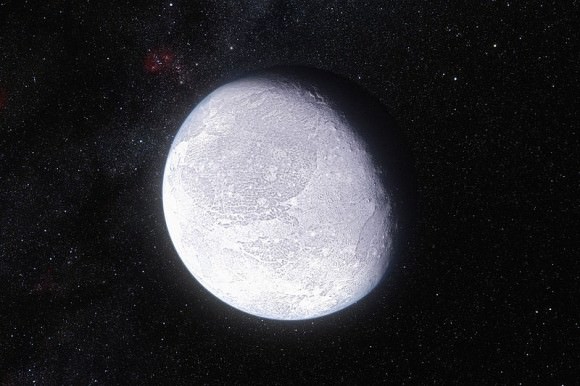
Though its existence was confirmed in 2005, it was not until the International Astronomical Union (IAU) conference in the summer of 2006 that the fate of Eris’ was decided. Under the IAU definition that was approved on August 24th, 2006, Eris was classified a “dwarf planet” – along with objects such as Pluto, Ceres, Haumea and Makemake – thereby reducing the number of known planets in the Solar System to eight.
Eris did come very close to being the tenth planet and newest planet in our Solar System though. Since many people are still unhappy with IAU’s definition of what constitutes a planet, there is a chance – although a very slight one – that Pluto and Eris may change categories and become the ninth and tenth planets respectively.
A few months after it was first observed by Brown and his team, a moon was also discovered in orbit around Eris (the newest planet’s newest moon?). This took place on September 10th, 2005, while a team at the Keck telescopes in Hawaii were carrying out observations of the four brightest TNOs (Pluto, Makemake, Haumea, and Eris). When Eris received its official name from the IAU, the moon received the name Dysnomia, after the Greek goddess of lawlessness who was Eris’s daughter.
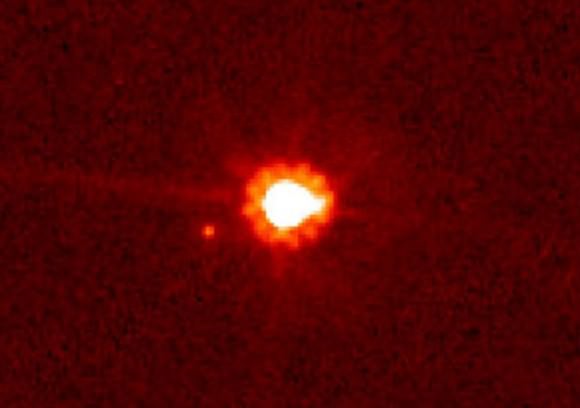
Given the uncertainties in official size estimates, which are largely due to interference from Pluto’s atmosphere, there is a reasonable chance that Eris is smaller than Pluto. However, when the New Horizons space probe arrives at Pluto in July 2015, scientists are expecting to get a better idea of Eris’ true size.
Naming of the Newest Planet
According to science writer and Dutch astronomer Govert Schilling, Brown initially wanted to call the object “Lila” – after a concept in Hindu mythology that described the cosmos as the outcome of a game played by Brahma – since it was very similar to Brown’s newborn daughter’s name “Lilah”. Brown had also speculated that Persephone, the wife of the god Pluto, would be a good name for the object.
However, this was not possible once the object was classified as a dwarf planet because of the asteroid that already has that name (399 Persephone). As a result, the discovery team proposed Eris on September 6th, 2006, and by the 13th, the name was accepted as the official name by the IAU.
Brown favored this name for two reasons. For one, Eris had been considered a planet for so long, leading him and others to believe that it deserved a name out of Greek or Roman mythology like the others. Second, Brown described Eris as his favorite goddess, and the name remained unclaimed despite just about every name in the Greco-Roman pantheon had been assigned to asteroids in the Solar System.
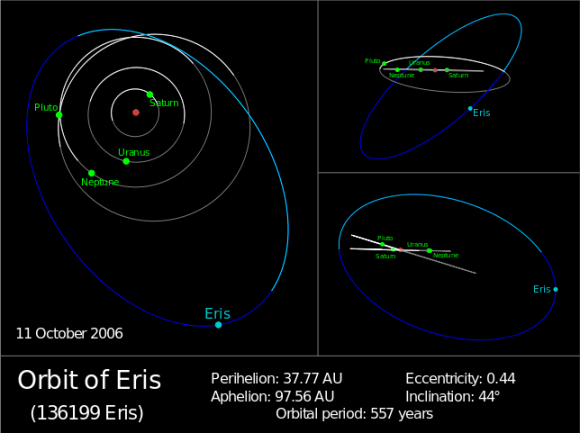
Extrasolar Planets
But, as already stated, there is also the matter of planets being discovered outside of our Solar System – aka. extrasolar planets. Identifying which is the latest planet to be discovered represents a bit of a challenge here, considering that since the first confirmed discovery in 1995, astronomers have been finding extrasolar planets at an astonishing rate.
As of May 2015, a total 1921 planets in 1214 planetary systems have been discovered, including 482 multiple planetary systems, mainly by the Kepler mission. And the latest to be discovered – thanks to teams working at the Lick Observatory in California, the Keck Observatory in Hawaii, and the Fairborn Observatory in Arizona – are the two exoplanets orbiting the HD 7924 star system (which is 54 light-years from us).
These planets – which have been designated HD 7924c and d – are both “super Earths”, with masses of about 7.9 and 6.4 times greater than Earth, respectively. They also happen to be the second and third planets discovered in that solar system (the other, called HD 7924b, was discovered in 2009).
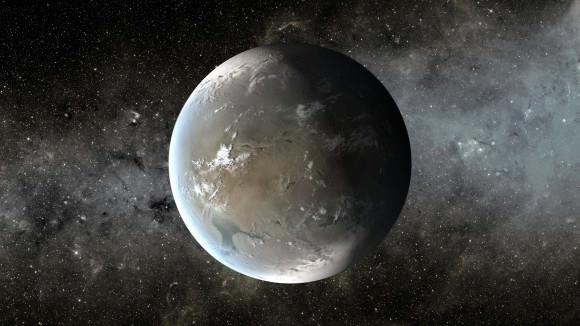
This shows that the newest extrasolar planet is always changing. There are sure to be new extrasolar planets discovered in the coming months, especially as astronomers develop more advanced techniques for finding these far off worlds and more observatories – such as TESS, the James Webb Space Telescope, or the Gaia spacecraft – are deployed.
And although it is unlikely, it is also possible that we will have new planets in our own Solar System. But this, as we’ve seen, will likely be due to a change in definitions rather than any new discoveries.
We have many interesting articles on new planets here at Universe Today, such as this article that deals with the topic of extrasolar planets.
If you are looking for more information, The Extrasolar Planets Encyclopaedia is a continually updating its catalog of extrasolar planets.
Astronomy Cast has an episode on extrasolar planets you will want to check out.

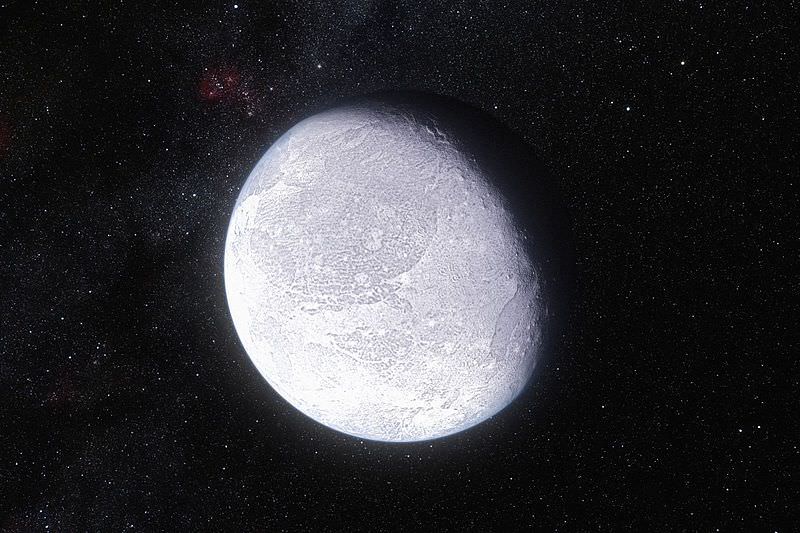
The ninth most massive (known) body in the Solar System is Mercury. Eris would be tenth.
If we are including the sun, Mercury is 9th, if not, Mercury is 8th, If you are looking at the mass of objects in the solar system, including moons then Eris and Pluto are not 9th or 10th. The order from Mercury on down is:
Mecury – 3.302 x 10^23 kg
Ganymede – 1.482×10^23 kg
Titan – 1.345×10^23 kg
Callisto – 1.076×10^23 kg
Io – 8.94 x 10^22kg
Luna (the moon) – 7.349×10^22kg
Europa – 4.8×10^22kg
Triton – 2.147 x 10^22 kg (Satellite of Neptune)
Eris – ~1.5 x 10^22 kg
Pluto – 1.305 x 10^22 kg
Haumea – 4.2 x 10^21 kg
which makes Eris/Pluto the 16/17th (or 17/18) most massive (known) objects in our solar system.
source of above is: http://www.suberic.net/~dmm/graphics/astro/size.html
Why are we considering Eris the newest planet in the Solar System, when other dwarf planets were discovered (and classified) afterwards, such as Makemake in 2005? Even there are other dwarf-planet-sized objects not officially classified as such discovered later than Eris (“newer”) such as Sedna (H=1.5), 2007 OR10 (H=2.0) and even 2013 FY27 (H=3.0).
By the IAU’s definition Neptune is probably the newest planet. It takes longer for a more distant object to clear its orbit, Neptune would (most likely) have been the last one to morph from a “dwarf planet” to a “planet.”
Except Neptune is really still a dwarf plant because it hasn’t cleared Pluto yet. But if we use a very generous definition of “planet” (ignoring things like Trojans, comets and Earth-crossing asteroids), 7 objects still qualify and Uranus was probably the last one to turn into a planet.
And the phrase “extrasolar planet” is an oxymoron so those don’t count! Per the IAU, an object must orbit the sun to be a planet. An extrasolar object, by definition, does not. It either orbits some other star or none at all. So by the accepted definition it is neither a planet nor a dwarf planet.
The sooner the IAU comes up with a definition for these extrasolar objects the better, because all this loose talk about new planets is only going to confuse the schoolchildren. They only have 10 fingers!
Oops, I knew I should have checked before I posted but I was too lazy.
I was VERY surprised to learn Eris out-massed Ganymede. But it never crossed my mind the author might have made two mistakes in one sentence, so I just believed it. 🙁
There was another obvious mistake in the article too… I’m pretty sure scientists are not “expecting to get a better idea of Eris’ true size” from the New Horizons flyby of Pluto…
I didn’t realize that Io was bigger than the moon.
Unfortunately, there are several inaccurate and erroneous statements in this article.
First is the inherent bias in the blind acceptance of one viewpoint in an ongoing debate, that of the IAU, as fact, when this is far from the case. Pluto did not “lose its status” in 2006. The vote by four percent of the IAU to demote Pluto, most of whom were not planetary scientists but other types of astronomers, was immediately rejected in a formal petition by hundreds of professional astronomers led by New Horizons Principal Investigator Alan Stern, who continue to reject it to this day. Many of them have written articles and books explaining their reasons for taking this position.
The astronomers who reject the IAU decision are not “unhappy” with it–they oppose it outright. Using a word like “unhappy” makes it sound like their position is based on emotion, which is highly misleading. Their position is based on a completely sound scientific view, specifically, the geophysical planet definition.
According to that definition, a planet is any non-self-luminous spheroidal body orbiting a star, free floating in space, or even orbiting another planet. If a celestial object is not a star and is large enough and massive enough to be squeezed into a round or nearly round shape by its own gravity, it is a planet, whether or not it “clears its orbit.”
It is wrong to privilege one view, that of four percent of the IAU, as the only legitimate or even “official” view out there when this is far from the case. The 2006 vote was merely one of many statements about Pluto made by various groups of scientists. It is not gospel truth, and no one is required to accept it.
Ironically, the term “dwarf planet” was first coined by Alan Stern, who used it to designate a third class of planets in addition to terrestrials and jovians. He never meant for dwarf planets to not be considered planets at all. The four percent of the IAU who voted on this misused his term. Adherents of the geophysical planet definition consider Pluto as well as Ceres, Haumea, Makemake, Eris, Sedna, etc. as planets.
Therefore, the chance of Eris, Pluto, etc. being considered planets is not at all “a slight one” as you state. Many professionals already consider them planets, and the IAU is not the sole venue for such decisions to be made. More important is usage; if a large number of those who study planets consider these objects planets, then that view will prevail. Consider further that those who actually sent a probe to Pluto, the New Horizons team, are the ones who will write the textbooks about this world, and most of them already consider dwarf planets to be full-fledged planets.
There is also some consideration being given to the formation of a professional planetary science organization that would address this burgeoning field independent of the IAU. One of the first tasks of such a group would likely be coming up with a better definition of planet.
It is disappointing to see you repeat the outdated claim that Eris is larger than Pluto. While it was initially thought to be so, in November 2010, a team of astronomers led by Bruno Sicardy obtained a more accurate measurement of Eris when it occulted a star and found it to be marginally smaller than Pluto though more massive. That was four and a half years ago–long enough to revise the initially erroneous information.
Eris was not discovered by Brown alone but by a team of three equal participants. One of those, Dr. David Rabinowitz, signed Stern’s petition rejecting the IAU decision. Unfortunately, the media fail to report the important fact that the discoverers of Eris are themselves divided over whether it should be considered a planet.
Neither Pluto nor Eris are “balls of ice and rock.” Pluto is estimated to be 70 percent rock, and Eris, being more massive than Pluto, is likely more rocky and even more planet-like.
While Govert Schilling is correct about Brown’s initial consideration of the name Lila based on Hindu mythology–along with equal consideration of the name Xena–the claim that this desire had anything to do with Brown’s daughter is false. As an astronomer, Brown is fully aware that according to convention agreed upon by professionals in the field, planetary bodies other than asteroids cannot be named for living people. None of Eris’s discoverers viewed it as an asteroid.
In our solar system, the most recent planet discovered is 2012 VP113, nicknamed “Biden.” Some scientists suspect there are Mars- or Earth-sized planets lurking even further beyond 2012 VP113 and Sedna.
Exoplanets cannot be considered planets at all by the IAU’s highly flawed definition, which requires planets to orbit “the Sun” rather than a star. That does not even take into account the issue of rogue planets. Clearly, a better definition, one that applies to both our solar system and others, is needed.
Why is Pluto not a planet? Because, the IAU reasoned,
“If it looks like a duck, swims like a duck and quacks like a duck, but there are more then ten of them, we need a new definition of ‘duck’.”
So the IAU had no choice but to take action. They could not afford to waste time on debate because the next discovery after Eris would have made eleven ducks.
There’s another interesting way to interpret the question: which planet was the last to form in our Solar System?